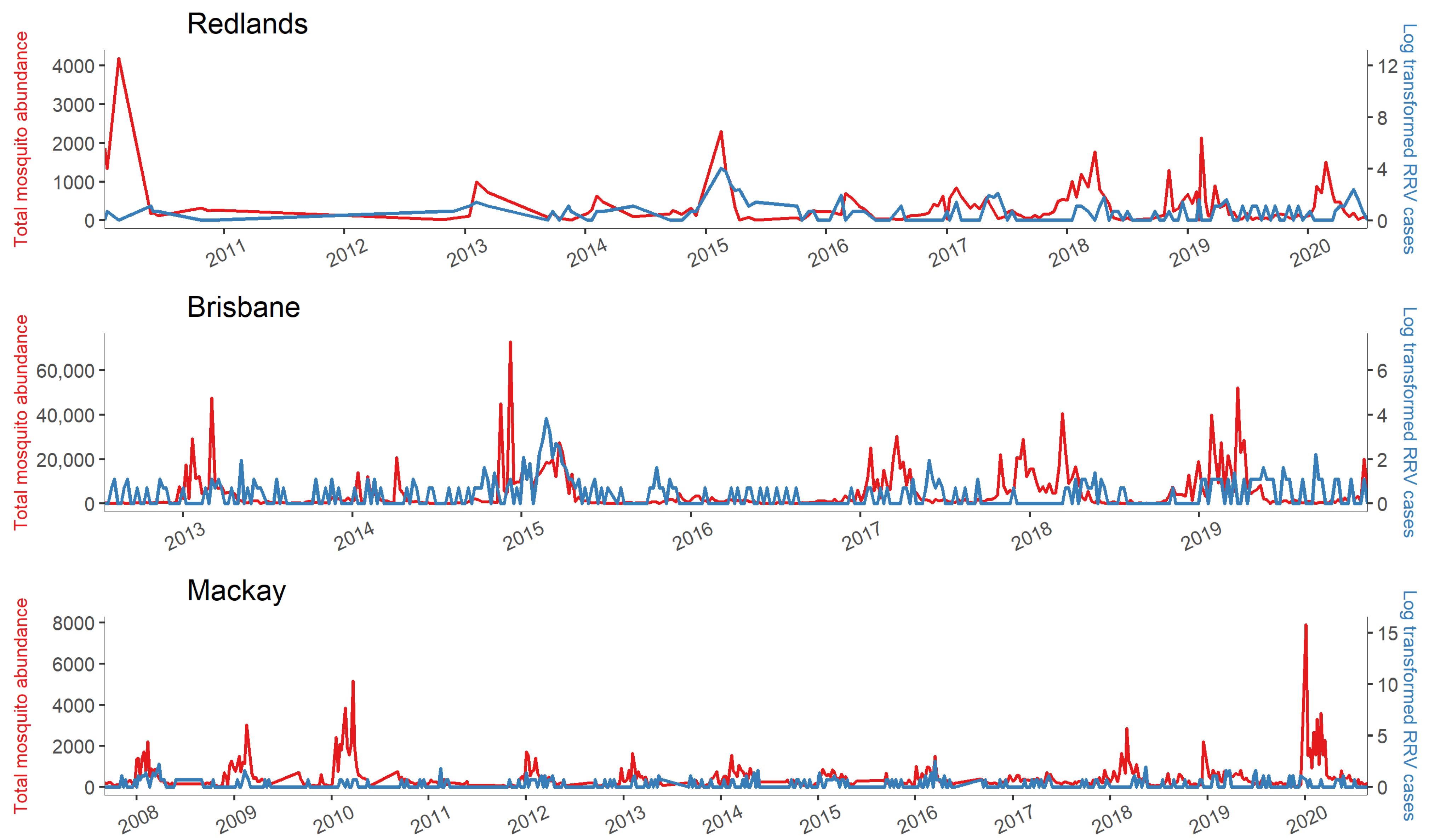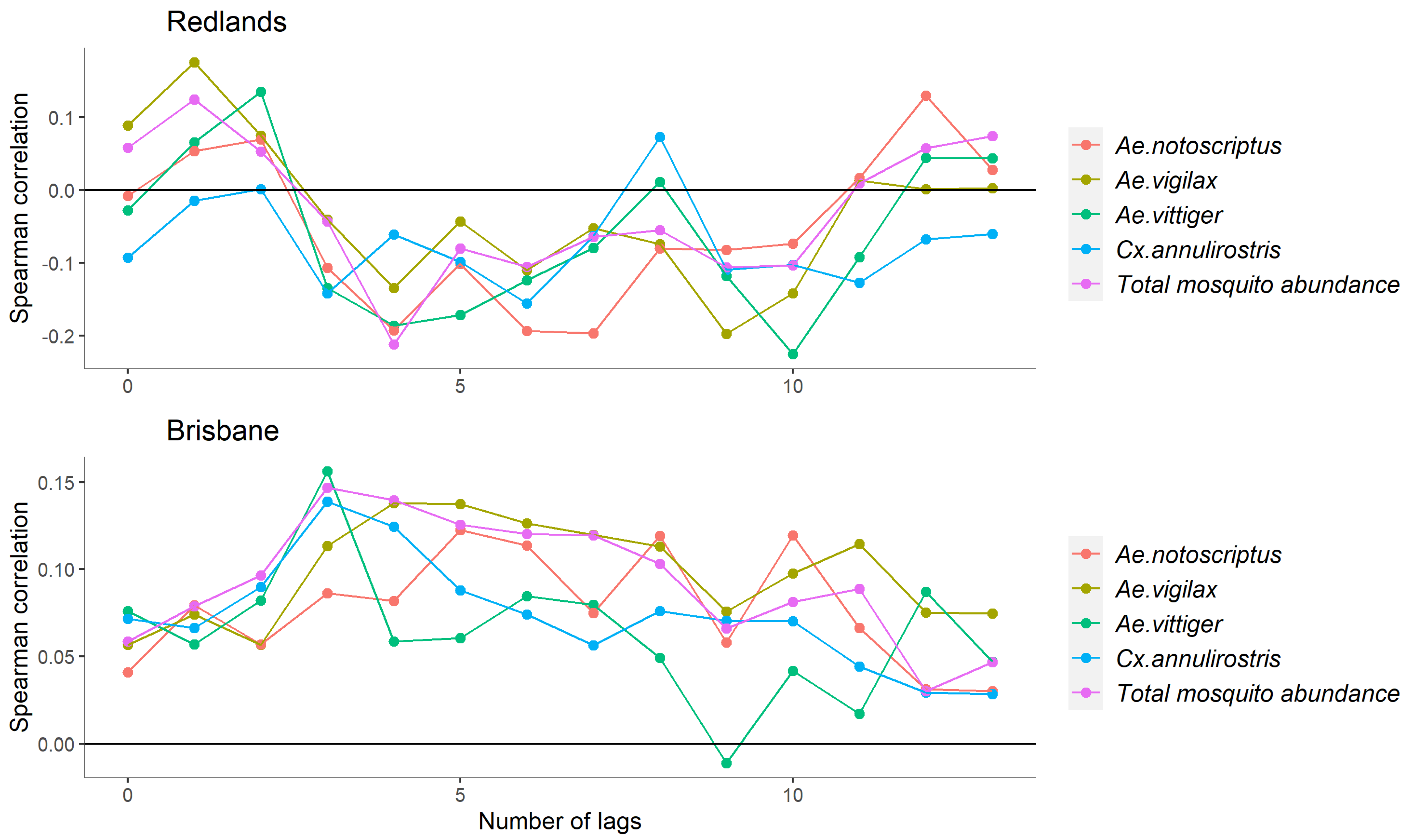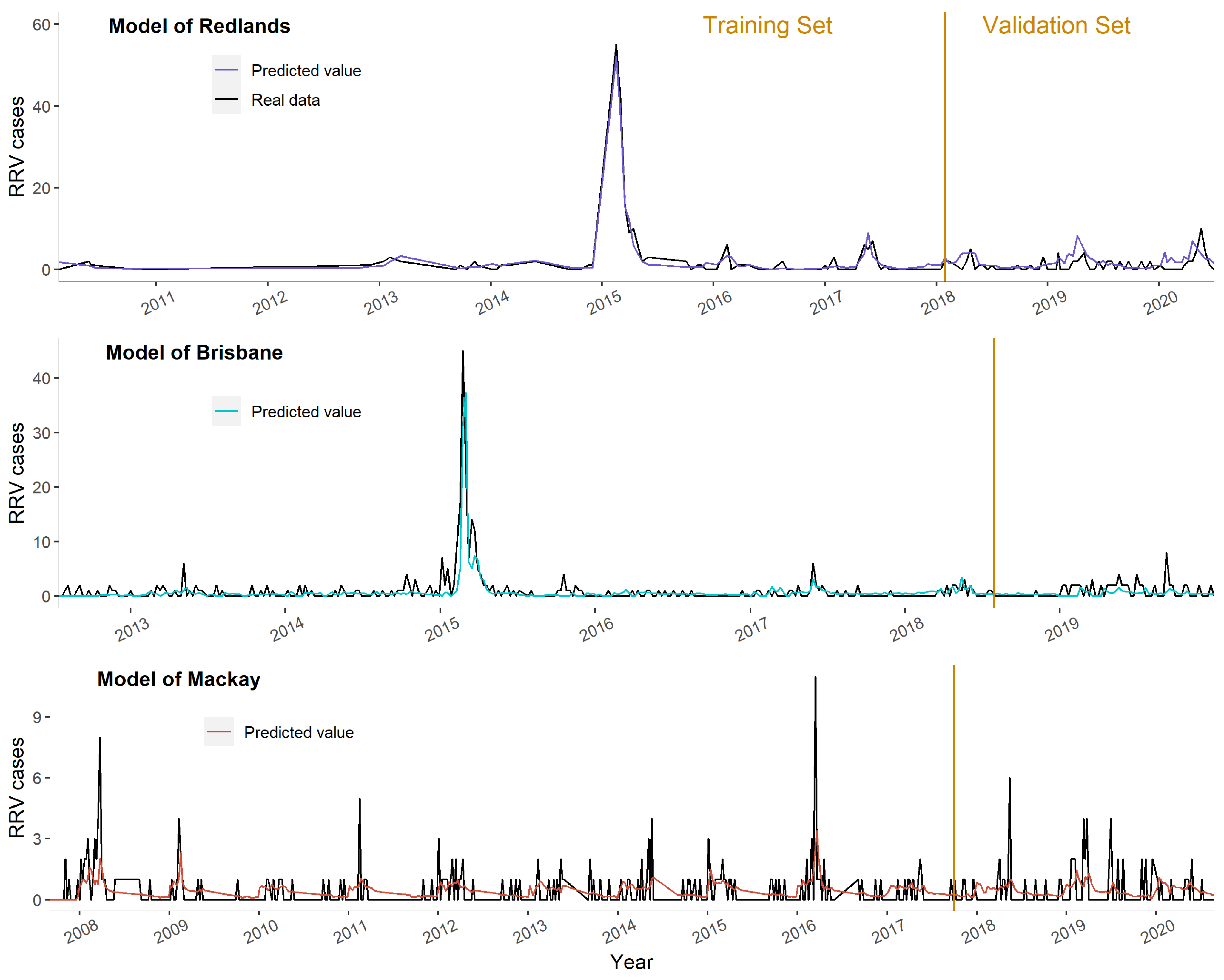Prediction of Ross River Virus Incidence Using Mosquito Data in Three Cities of Queensland, Australia
Abstract
:Simple Summary
Abstract
1. Introduction
2. Materials and Methods
2.1. Study Design and Study Area
2.2. Data Collection and Collation
2.3. Predictor Selection
2.4. Model Building
2.5. Ethics Statement
3. Results
4. Discussion
5. Conclusions
Supplementary Materials
Author Contributions
Funding
Institutional Review Board Statement
Informed Consent Statement
Data Availability Statement
Acknowledgments
Conflicts of Interest
References
- Australian Department of Health. National Notifiable Disease Surveillance System. 2021. Available online: http://www9.health.gov.au/cda/source/cda-index.cfm (accessed on 14 March 2021).
- Stephenson, E.B.P.A.; Reid, S.A.; Jansen, C.C.; McCallum, H. The non-human reservoirs of Ross River virus: A systematic review of the evidence. Parasites Vectors 2018, 11, 188. [Google Scholar] [CrossRef] [PubMed]
- Qian, W.; Viennet, E.; Glass, K.; Harley, D. Epidemiological models for predicting Ross River virus in Australia: A systematic review. PLoS Neglected Trop. Dis. 2020, 14, e0008621. [Google Scholar] [CrossRef] [PubMed]
- Harley, D.; Ritchie, S.; Phillips, D.; van den Hurk, A. Mosquito isolates of Ross River virus from Cairns, Queensland, Australia. Am. J. Trop. Med. Hyg. 2000, 62, 561–565. [Google Scholar] [CrossRef] [PubMed]
- Ritchie, S.A.; Fanning, I.D.; Phillips, D.A.; Standfast, H.A.; Mcginn, D.; Kay, B.H. Ross River Virus in Mosquitoes (Diptera: Culicidae) During the 1994 Epidemic Around Brisbane, Australia. J. Med. Èntomol. 1997, 34, 156–159. [Google Scholar] [CrossRef] [PubMed]
- Tong, S.; Hu, W.; Nicholls, N.; Dale, P.; MacKenzie, J.S.; Patz, J.; McMichael, A.J. Climatic, high tide and vector variables and the transmission of Ross River virus. Intern. Med. J. 2005, 35, 677–680. [Google Scholar] [CrossRef] [PubMed]
- Hu, W.; Tong, S.; Mengersen, K.; Oldenburg, B. Rainfall, mosquito density and the transmission of Ross River virus: A time-series forecasting model. Ecol. Model. 2006, 196, 505–514. [Google Scholar] [CrossRef]
- Hu, W.; Tong, S.; Mengersen, K.; Oldenburg, B.; Dale, P. Mosquito species (Diptera: Culicidae) and the transmission of Ross River virus in Brisbane, Australia. J. Med. Entomol. 2006, 43, 375–381. [Google Scholar] [CrossRef]
- Flies, E.J.; Weinstein, P.; Anderson, S.J.; Koolhof, I.; Foufopoulos, J.; Williams, C.R. Ross River Virus and the Necessity of Multiscale, Eco-epidemiological Analyses. J. Infect. Dis. 2018, 217, 807–815. [Google Scholar] [CrossRef]
- Jacups, S.P.; Whelan, P.I.; Markey, P.G.; Cleland, S.J.; Williamson, G.J.; Currie, B.J. Predictive indicators for Ross River virus infection in the Darwin area of tropical northern Australia, using long-term mosquito trapping data. Trop. Med. Int. Health 2008, 13, 943–952. [Google Scholar] [CrossRef]
- Walker, L.J.; Selvey, L.A.; Jardine, A.; Johansen, C.A.; Lindsay, M.D.A. Mosquito and Virus Surveillance as a Predictor of Human Ross River Virus Infection in South-West Western Australia: How Useful Is It? Am. J. Trop. Med. Hyg. 2018, 99, 1066–1073. [Google Scholar] [CrossRef]
- Cutcher, Z.; Williamson, E.; Lynch, S.E.; Rowe, S.; Clothier, H.J.; Firestone, S.M. Predictive modelling of Ross River virus notifications in southeastern Australia. Epidemiol. Infect. 2017, 145, 440–450. [Google Scholar] [CrossRef] [PubMed]
- Woodruff, R.E.; Guest, C.S.; Garner, M.G.; Becker, N.; Lindsay, M. Early warning of Ross River virus epidemics: Combining surveillance data on climate and mosquitoes. Epidemiology 2006, 17, 569–575. [Google Scholar] [CrossRef] [PubMed]
- Barton, P.S.; Weaver, H.J. Mosquito (Diptera: Culicidae) and Rainfall Associations with Arbovirus Disease in Eastern Victoria. Trans. R. Soc. S. Aust. 2009, 133, 257–264. [Google Scholar] [CrossRef]
- Hu, W.; Mengersen, K.; Dale, P.; Tong, S. Difference in Mosquito Species (Diptera: Culicidae) and the Transmission of Ross River Virus Between Coastline and Inland Areas in Brisbane, Australia. Environ. Èntomol. 2010, 39, 88–97. [Google Scholar] [CrossRef] [PubMed]
- Williams, C.R.; Fricker, S.R.; Kokkinn, M.J. Environmental and entomological factors determining Ross River virus activity in the River Murray Valley of South Australia. Aust. N. Z. J. Public Health 2009, 33, 284–288. [Google Scholar] [CrossRef] [PubMed]
- Australian Bureau of Statistics. Regional Population. 2022. Available online: https://www.abs.gov.au/statistics/people/population/regional-population/2021 (accessed on 9 November 2022).
- Qian, W.; Hurst, C.; Glass, K.; Harley, D.; Viennet, E. Spatial and Temporal Patterns of Ross River Virus in Queensland, 2001–2020. Trop. Med. Infect. Dis. 2021, 6, 145. [Google Scholar] [CrossRef] [PubMed]
- Claflin, S.B.; Webb, C.E. Ross River Virus: Many Vectors and Unusual Hosts Make for an Unpredictable Pathogen. PLoS Pathog. 2015, 11, e1005070. [Google Scholar] [CrossRef]
- Queensland Government. Queensland Local Government Areas (LGA). 2021. Available online: https://www.qgso.qld.gov.au/visualisations-geographies/geographical-boundaries/queensland-local-government-areas-lga-2021 (accessed on 10 August 2023).
- Ryan, P.A.; Lyons, S.A.; Alsemgeest, D.; Thomas, P.; Kay, B.H. Spatial Statistical Analysis of Adult Mosquito (Diptera: Culicidae) Counts: An Example Using Light Trap Data, in Redland Shire, Southeastern Queensland, Australia. J. Med. Èntomol. 2004, 41, 1143–1156. [Google Scholar] [CrossRef]
- Stewart, I.; Oke, T. Newly developed “thermal climate zones” for defining and measuring urban heat island magnitude in the canopy layer. In Proceedings of the Eighth Symposium on Urban Environment, Phoenix, AZ, USA, 10 January 2009. [Google Scholar]
- Queensland Government. Queensland Land Use Mapping Program (QLUMP). 2021. Available online: https://www.qld.gov.au/environment/land/management/mapping/statewide-monitoring/qlump (accessed on 22 March 2021).
- Australian Department of Health. Ross River Virus Infection Case Definition. 2016. Available online: https://www1.health.gov.au/internet/main/publishing.nsf/Content/cda-surveil-nndss-casedefs-cd_rrv.htm (accessed on 14 March 2021).
- Australian Government. The Australian Bureau of Statistics. 2019. Available online: http://www.abs.gov.au (accessed on 14 September 2018).
- Australian Government. The Australian Bureau of Meteorology. 2021. Available online: http://www.bom.gov.au/ (accessed on 1 March 2022).
- Brisbane City Council. Brisbane City Council. 2023. Available online: https://www.brisbane.qld.gov.au/ (accessed on 7 November 2023).
- Redland City Council. Redland City Council. 2023. Available online: https://www.redland.qld.gov.au/ (accessed on 7 November 2023).
- Mackay City Council. Mackay Regional Council. 2023. Available online: https://www.mackay.qld.gov.au/ (accessed on 7 November 2023).
- Jansen, C.C.; Shivas, M.A.; May, F.J.; Pyke, A.T.; Onn, M.B.; Lodo, K.; Hall-Mendelin, S.; McMahon, J.L.; Montgomery, B.L.; Darbro, J.M.; et al. Epidemiologic, entomologic, and virologic factors of the 2014–15 Ross River virus outbreak, Queensland, Australia. Emerg. Infect. Dis. 2019, 25, 2243. [Google Scholar] [CrossRef]
- QGIS Development Team. QGIS Geographic Information System; Open Source Geospatial Foundation Project, 2023. [Google Scholar]
- Hosmer, D.W.; Lemeshow, S. Applied Survival Analysis: Regression Modeling of Time to Event Data; Wiley: New York, NY, USA, 1999. [Google Scholar]
- Qian, W.; Harley, D.; Glass, K.; Viennet, E.; Hurst, C. Prediction of Ross River virus incidence in Queensland, Australia: Building and comparing models. PeerJ 2022, 10, e14213. [Google Scholar] [CrossRef]
- Ripley, B.; Venables, B.; Bates, D.M.; Hornik, K.; Gebhardt, A.; Firth, D. MASS: Support Functions and Datasets for Venables and Ripley’s MASS, R Package Version 4.1.0; R Foundation for Statistical Computing: Vienna, Austria, 2021. [Google Scholar]
- Jackman, S.; Tahk, A.; Zeileis, A.; Maimone, C.; Fearon, J.; Meers, Z. Pscl: Political Science Computational Laboratory, R Package Version 4.1.0; R Foundation for Statistical Computing: Vienna, Austria, 2020. [Google Scholar]
- R Core Team. R: A Language and Environment for Statistical Computing; R Foundation for Statistical Computing: Vienna, Austria, 2020. [Google Scholar]
- Ryan, P.A.; Alsemgeest, D.; Gatton, M.L.; Kay, B.H. Ross River virus disease clusters and spatial relationship with mosquito biting exposure in Redland Shire, southern Queensland, Australia. J. Med. Entomol. 2006, 43, 1042–1059. [Google Scholar] [CrossRef] [PubMed]
- Knight, J.; Griffin, L.; Dale, P.; Phinn, S. Oviposition and Larval Habitat Preferences of the Saltwater Mosquito, Aedes vigilax, in a Subtropical Mangrove Forest in Queensland, Australia. J. Insect Sci. 2012, 12, 1–11. [Google Scholar] [CrossRef] [PubMed]
- Webb, C.; Doggett, S.; Russell, R. Guide to Mosquitoes of Australia; CSIRO Publishing: Clayton South, VIC, Australia, 2016; ISBN 9780643104464. [Google Scholar]
- Boyd, A.M.; Kay, B.H. Vector Competence of Aedes aegypti, Culex sitiens, Culex annulirostris, and Culex quinquefasciatus (Diptera: Culicidae) for Barmah Forest Virus. J. Med. Èntomol. 2000, 37, 660–663. [Google Scholar] [CrossRef] [PubMed]
- Watson, T.M.; Kay, B.H. Vector competence of Aedes notoscriptus (Diptera: Culicidae) for Ross River virus in Queensland, Australia. J. Med. Èntomol. 1998, 35, 104–106. [Google Scholar] [CrossRef] [PubMed]
- Peterson, A.T.; Campbell, L.P. Global potential distribution of the mosquito Aedes notoscriptus, a new alien species in the United States. J. Vector Ecol. 2015, 40, 191–194. [Google Scholar] [CrossRef] [PubMed]
- Tomerini, D.M. The Impact of Local Government Mosquito Control Programs on Ross River Virus Disease in Queensland, Australia; Griffith University: Queensland, Australia, 2008. [Google Scholar]
- Tomerini, D.M.; Dale, P.E.; Sipe, N. Does Mosquito Control Have an Effect on Mosquito-Borne Disease? The Case of Ross River Virus Disease and Mosquito Management in Queensland, Australia. J. Am. Mosq. Control Assoc. 2011, 27, 39–44. [Google Scholar] [CrossRef] [PubMed]
- Johnson, B.J.; Robbins, A.; Gyawali, N.; Ong, O.; Loader, J.; Murphy, A.K.; Hanger, J.; Devine, G.J. The environmental and ecological determinants of elevated Ross River Virus exposure in koalas residing in urban coastal landscapes. Sci. Rep. 2021, 11, 4419. [Google Scholar] [CrossRef]
- Fox, J. Applied Regression Analysis and Generalized Linear Models; Sage Publications: Thousand Oaks, CA, USA, 2015. [Google Scholar]
- MaCurdy, T.E.; Pencavel, J.H. Testing between competing models of wage and employment determination in unionized markets. J. Political Econ. 1986, 94, S3–S39. [Google Scholar] [CrossRef]
- Ng, V.; Dear, K.; Harley, D.; McMichael, A. Analysis and prediction of ross river virus transmission in New South Wales, Australia [Review]. Vector-Borne Zoonotic Dis. 2014, 14, 422–438. [Google Scholar] [CrossRef]




| Redlands | Brisbane | Mackay | |
|---|---|---|---|
| Climate of the research area | Subtropical climate with hot, humid summers, and dry, moderately warm winters. Thunderstorms occasionally occur during the summer and cause waterlogging. | Tropical climate with hot, humid summers, and dry, warm, sunny winters with cool nights. Tropical cyclones, thunderstorms, and subsequent floods occasionally occur during the summer. | |
| Geographical situation of the research area | Coastal city with diverse natural environment, including several islands, coastline, bushlands, national parks, and waterways. Elevation: from 0 m to 233 m. | Subcoastal city with substantial residential and agricultural lands and natural environments, including bushlands, forests, mountains, and the Brisbane River. Elevation: from 3 m to 512 m. | Coastal city at the mouth of the Pioneer River with both residential areas and natural environments, including a long coastline and rainforests, islands, and gardens. Elevation: from 0 m to 65 m. |
| Socio-economic situation of the research area | The mainland of Redlands is made up of urban and suburban areas close to Brisbane City. Islands including North Stradbroke Island have few residents but have common visitors. Average population density of around 307 persons per square km. | Brisbane is the capital of Queensland and Australia’s third-largest city. Populous urban city (average population density: around 1270 persons per square km). | Mackay is a moderate city with an average population density around 595 persons per square km, and is popular with visitors; it is also known as the “sugar capital” of Australia. |
| Research period | 1 January 2010–30 June 2020 | 1 July 2012–30 December 2019 | 1 September 2007–30 August 2020 |
| Number of SA2 areas included in this analysis | 8 | 10 | 7 |
| Observations with mosquito abundance data (total RRV cases) | 1231 (278) | 3495 (376) | 3349 (246) |
| Mosquito data (weekly data at SA2s) | Abundance of Cx.annulirostris, Ae.vittiger, Ae.notoscriptus, Ae.vigilax, and total mosquitoes and two of the weekly lags of these abundances within three months. | Total mosquito abundance and two weekly lags of total abundance within three months. | |
| Meteorological, geographical, and socio-economic exposures (weekly data at SA2s) and recent RRV cases | Max air temperature, range of air temperature, relative humidity at the time of maximum temperature, relative humidity at the time of minimum temperature, rainfall, vapour pressure at 3 p.m., pan evaporation, evapotranspiration, Southern Oscillation Index, El Niño events, La Niña events, normalized difference vegetation index, and two weekly lags of these exposures within one year. Socio-economic index for areas, week number of a year, and the log-transformed value of weighted moving average of recent RRV cases in the past month. | ||
| Dataset † | Predictors †† | Standardised Coefficients |
|---|---|---|
| Redlands | Vapour pressure lag 35 | −0.630 *** |
| El Niño lag 51 | −0.515 *** | |
| Recent cases | 0.515 *** | |
| RHMin | 0.224 | |
| RHMax lag 7 | 0.159 | |
| Rainfall | −0.018 | |
| Brisbane | Recent cases | 0.463 *** |
| RHMin lag 36 | −0.332 *** | |
| Vapour pressure lag 9 | 0.222 | |
| Vapour pressure lag 29 | −0.196 | |
| Ae.vigilax lag 5 | −0.156 | |
| Week | −0.131 | |
| Cx.annulirostris lag 14 | −0.126 | |
| Cx.annulirostris | 0.119 * | |
| Evapotranspiration lag 12 | −0.105 | |
| RHMax | 0.088 | |
| Ae.notoscriptus lag 14 | 0.070 | |
| Vapour pressure | −0.030 | |
| Cx.annulirostris lag 4 | 0.024 | |
| Total mosquito abundance lag 13 | 0.018 | |
| Ae.notoscriptus lag 6 | −0.008 | |
| Ae.vigilax lag 1 | −0.007 | |
| Total mosquito abundance lag 4 | −0.006 | |
| Mackay | Week | −0.520 *** |
| Recent cases | 0.293 *** | |
| Rainfall lag 45 | −0.231 | |
| TempR lag 51 | −0.056 | |
| NDVI lag 49 | 0.009 |
Disclaimer/Publisher’s Note: The statements, opinions and data contained in all publications are solely those of the individual author(s) and contributor(s) and not of MDPI and/or the editor(s). MDPI and/or the editor(s) disclaim responsibility for any injury to people or property resulting from any ideas, methods, instructions or products referred to in the content. |
© 2023 by the authors. Licensee MDPI, Basel, Switzerland. This article is an open access article distributed under the terms and conditions of the Creative Commons Attribution (CC BY) license (https://creativecommons.org/licenses/by/4.0/).
Share and Cite
Qian, W.; Viennet, E.; Glass, K.; Harley, D.; Hurst, C. Prediction of Ross River Virus Incidence Using Mosquito Data in Three Cities of Queensland, Australia. Biology 2023, 12, 1429. https://doi.org/10.3390/biology12111429
Qian W, Viennet E, Glass K, Harley D, Hurst C. Prediction of Ross River Virus Incidence Using Mosquito Data in Three Cities of Queensland, Australia. Biology. 2023; 12(11):1429. https://doi.org/10.3390/biology12111429
Chicago/Turabian StyleQian, Wei, Elvina Viennet, Kathryn Glass, David Harley, and Cameron Hurst. 2023. "Prediction of Ross River Virus Incidence Using Mosquito Data in Three Cities of Queensland, Australia" Biology 12, no. 11: 1429. https://doi.org/10.3390/biology12111429





